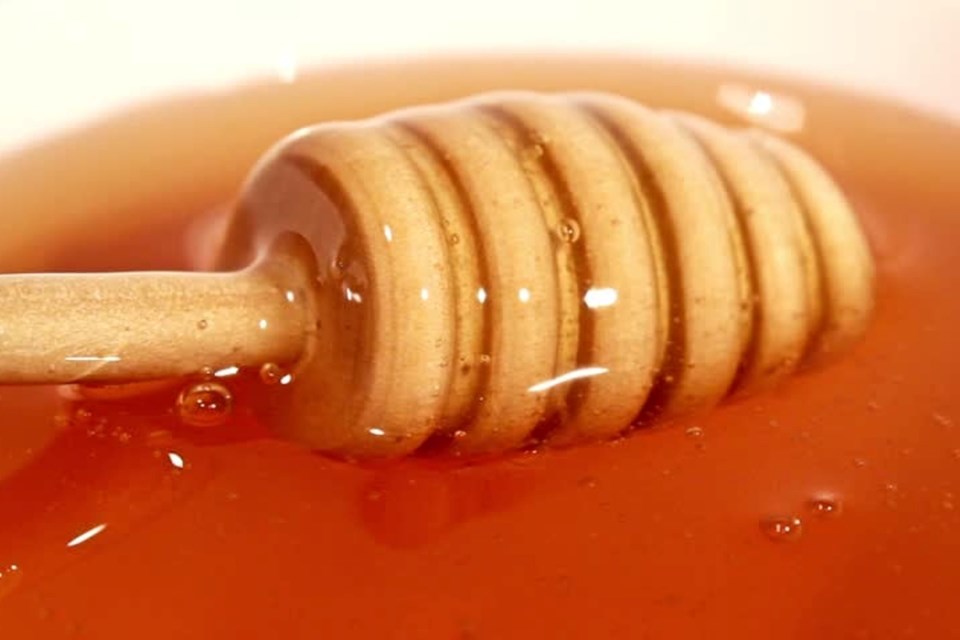“Oh honey, let’s build an apiary!” That’s pretty much how Adelle Larmour-DeLong’s honey bee adventure began.
“I was working with a fellow at a fabrication company who was getting into the market and I found everything about the insect so fascinating,” she said.
Larmour-DeLong started building the Off The Bee’tn Path apiary in 2011 and began producing liquid gold with an official Ministry of Food and Agriculture licence in 2015.
The apiary is located on 67 acres of land in Wahnapitae, southeast of Sudbury, where she also grows and sells organic garlic. Another apiary is located on a friend’s nearby property.
This winter, both items were sold at the Indoor Farmer’s Market at Science North. And while she's almost sold out of her hundreds of pounds of honey until the next harvest, she will continue to sell honey for other local vendors as a proud member of the Sudbury and District Beekeepers Association.
This year, Larmour-DeLong also began playing with flavoured honey-butter combinations, offering four different varieties: garlic honey, garlic hot pepper honey, hot pepper and ginger creamed honey.
Each distinct variety has become quite the hot commodity with lots of customers sharing suggestions to vie for the next great honey fusion.
It’s important to note that while customers love these combinations, the bees are not a fan of garlic.
“I once went out to tend to the bees with garlic on my breath. It was then I learned that the bees get very aggressive when they smell garlic,” she warned.
Both Larmour-DeLong and her husband, Tom, are originally from the Niagara region. While she loves the honey bees, Tom is more interested in creating the wooden wares or trays that house the bees.
“I like to talk to the bees, even if that sounds strange. They know me by now. They know my voice and my gentleness,” Larmour-DeLong said.
This past winter, her husband did help with the creation of what she thinks is a first ever for the region. The honey bee cottage was developed to help weaker bees survive over cold winters. These bees are isolated with a metal smoker when the weather gets cooler and then transferred to the heated cottage until the cold passes.
During our walking tour on a hot spring day, you could actually smell the sweet fragrance of honey lingering in the air above the hives.
There are thousands of bees living in each hive, and an electric fence lines the perimeter to keep the bears at bay.
“Last year we had a mom and her cubs lingering around the area. The bears will not only go after the honey, but also the bees and larvae for protein stores in the process, so that is scary for us,” she said.
It becomes quite evident that every bee has its job and the hive exists in a very orderly fashion. The worker bees take care of larvae, the foragers look for food and pollen, and the guard bees are the ones that buzz noisily around our heads to protect everyone.
Larmour-DeLong can always locate the queen bee with her peanut-shaped body. This bee keeps everyone alive, and working happily and productively.
“We’d get lots of work done if humans work like the bees do, but we don’t,” Larmour-DeLong said.
Adelle tries to spend an hour or two checking on hives per day to assess the brood or eggs that produce more bees. She checks on her queen bees so the colony does not panic and leave. She sometimes provides sugar water to feed the bees and keep them happy and producing.
Then, in winter comes the rewards of honey. Larmour-DeLong uses a heated bottler in her certified commercial kitchen to pour batches from pails.
Depending on what the bees have foraged on, the honey can vary in colour. Hers feed off wildflowers mainly, so the colour is generally very golden.
“I try not to use too much heat in the process because I appreciate the raw goodness of the honey,” she said.
It’s something that she didn’t always appreciate until now as the raw liquid gold really is the fruits of her labour.
For more information, OffTheBeetnPath.com or the Facebook page at Off the Bee’tn Path Sudbury.
Anastasia Rioux is a writer in Greater Sudbury. Let’s eat! is made possible by our Community Leaders Program.
